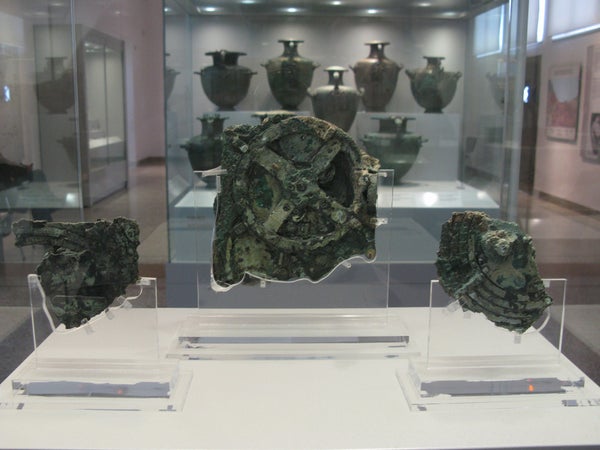The most sophisticated mechanical device of ancient Greece may finally be giving up its secrets. Researchers have long known the so-called Antikythera mechanism was a calendar of sorts that represented the positions of the sun and moon using a series of gears. In its complexity it outshined all other objects for a thousand years following its creation sometime around the second century B.C. Now an international consortium of researchers has probed the machine's corroded fragments with sophisticated x-ray and light imaging tools to uncover the true sophistication of this geared wonder.
The device could predict eclipses as well as reproduce a subtle irregularity in the moon's orbit, they reveal. Moreover, it may have been able to represent the motions of the planets, although the necessary gears seem to be long gone. They also confirm a prior hypothesis that the device relied on spiral grooves to count off certain lunar cycles. "We don't know what it was for but we do believe we know what it did," says astronomer Mike Edmunds of Cardiff University in Wales.
On supporting science journalism
If you're enjoying this article, consider supporting our award-winning journalism by subscribing. By purchasing a subscription you are helping to ensure the future of impactful stories about the discoveries and ideas shaping our world today.
Divers recovered the Antikythera instrument in 1901 from a 2,000-year-old shipwreck that had sunk beneath the Mediterranean Sea, midway between Greece's Peloponnesian peninsula and the island Crete. What they found was a hunk of calcified bronze gears and other fragments, along with a decayed wooden box that had housed the mechanism. In pioneering work begun in the 1950s (and first described in a 1959 Scientific American article), the late science historian Derek Price reasoned that this encrusted mess was a solar-lunar calendar. The box would open in the front to reveal a dial with rotating gear-driven pointers to mark off the sun's position and the phases of the moon. The back of the device contained two dials that counted off other cycles.
Looking to confirm and build on some recent insights into the Antikythera machine's function, Edmunds and his colleagues collaborated with the National Bank of Greece Cultural Foundation, Hewlett-Packard Laboratories and other institutions to scan the fragments using two new methods. To study the mechanism's fine surface details, they took multiple digital images each lit from a different direction, which allowed them to virtually rotate the object in the light [see interactive images here and a rotating view of the main fragment here]. They also probed below the corrosion using a custom x-ray tomography system [see video here].
"We've at least doubled the amount of inscription that was known," reports Edmunds, whose group has published its findings in the November 30 Nature. Notably, the word "stationary" appears several times, perhaps referring to planetary motion, which seems to halt at times because of Earth's relative orbital motion, the group speculates. Other inscriptions include "Aphrodite" or "Venus," "little golden sphere" (referring presumably to the marker for the sun) and "trunnion," a mechanical pivot. The researchers say the markings date the device from 150 to 100 B.C.
The two dials in the rear of the mechanism seem to represent eclipses and a combined solar-lunar calendar. The so-called Metonic cycle is based on the near equivalence of 235 lunar months to 19 solar years. The group found 34 regular markings on one gear fragment. They estimate that the full gear would contain 235 divisions along a spiral of five concentric rings. As the arm that marked the lunar month rotated, a pointer similar to a record player's needle may have slid along the spiral groove to pick out the correct month. Significantly, an inscription on one of the wooden fragments reads "spiral divided into 235 sections," the group reports. An additional pair of gears seems to have accounted for a slight variation in the moon's motion across the sky.
Another gear fragment exhibits markings consistent with a four-turn spiral divided into 223 segments, the same number of lunar months that can elapse between eclipses. Between these divisions the researchers say they found the Greek letters sigma and eta, which could stand for Selene and Helios, the Greek words for moon and sun.
The findings are "seductive" and will set the standard for future work, says medieval science historian Francois Charette of Ludwig Maximilian University in Munich. "Everything in their model fits very well with the data they have collected, and just happens to give the relationships that were used in Greek astronomy for these cycles," he says. The researchers plan to make their data available online for others to examine, their report states.
As for the purpose of the Antikythera instrument, Charette says it strikes him as a luxury object, given that numerical tables could have done the same job for less trouble. Craftsmen built similarly elaborate clocks and astrolabes during medieval and Renaissance times, he says. "They were expensive toys."
